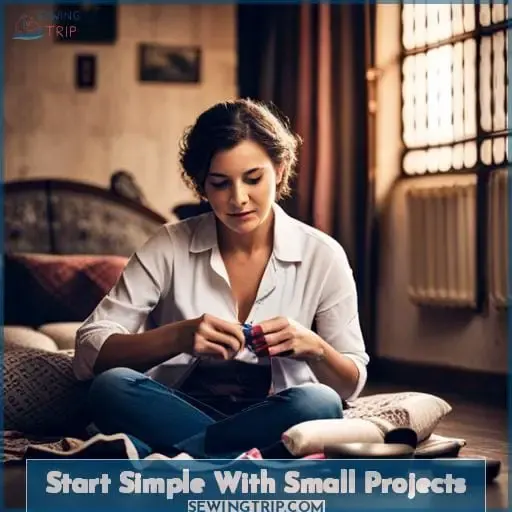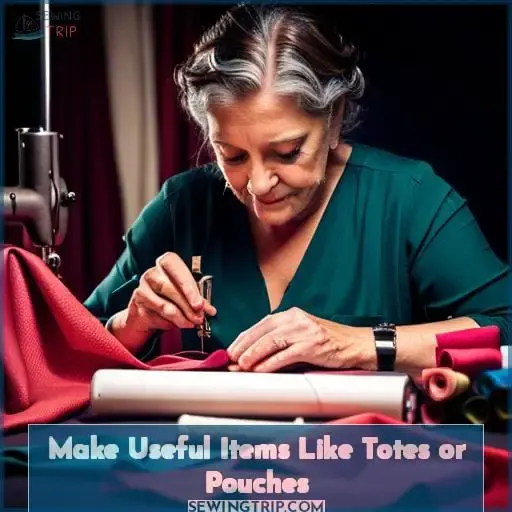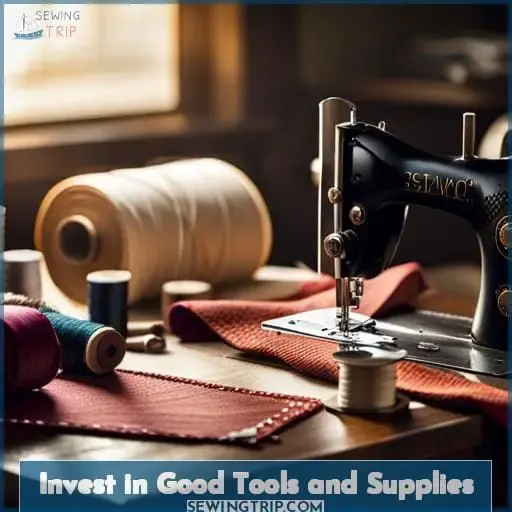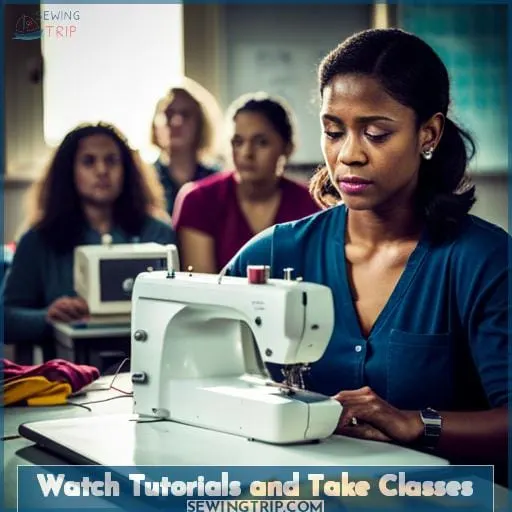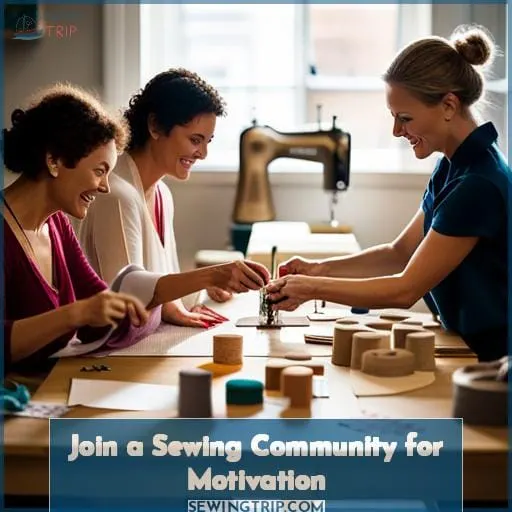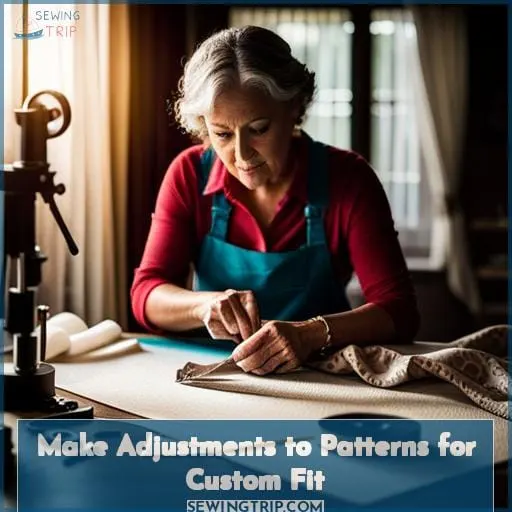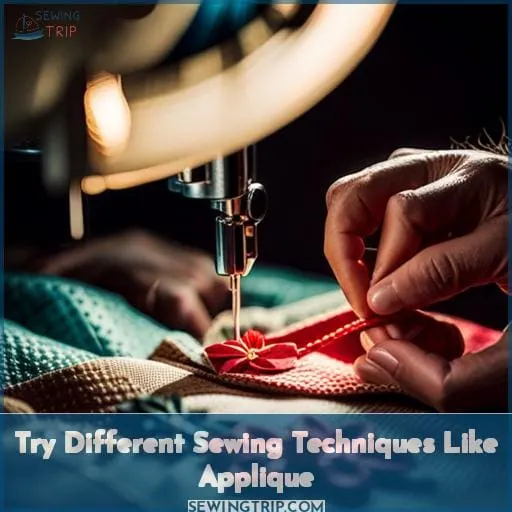This site is supported by our readers. We may earn a commission, at no cost to you, if you purchase through links.

Don’t know where to begin exploring this creative hobby?
Start with small, simple projects using fun, colorful fabrics and accessories.
Learn basic skills like sewing seams and hemming to build your confidence.
Challenge yourself with custom designs as your abilities grow.
Join an online sewing community for inspiration and connect with experienced sewers.
With persistence and the right mindset, sewing can become an empowering outlet for self-expression.
Let’s dive in and ignite your passion for sewing!
Table Of Contents
- Key Takeaways
- Start Simple With Small Projects
- Choose Fun, Inspiring Fabric
- Make Useful Items Like Totes or Pouches
- Learn Basic Skills Like Seams and Hemming
- Invest in Good Tools and Supplies
- Watch Tutorials and Take Classes
- Join a Sewing Community for Motivation
- Make Adjustments to Patterns for Custom Fit
- Try Different Sewing Techniques Like Applique
- Set Goals and Challenge Yourself
- Frequently Asked Questions (FAQs)
- Conclusion
Key Takeaways
- Start with simple beginner sewing projects like zipper pouches, tote bags, or aprons to learn fundamental skills.
- Select fun, bold fabrics and prints that inspire creativity.
- Master basic sewing techniques like different stitches, seams, and hemming.
- Invest in quality sewing tools and materials to enable progress.
Start Simple With Small Projects
When starting sewing, begin with small, simple projects to build skills without getting overwhelmed.
Start with quick and easy patterns like zipper pouches, tote bags, scrunchies, aprons, or face masks.
These quick wins build confidence as you gain sewing skills and master the basics.
Frustration is minimized when you can try your hand at sewing and complete achievable projects.
Don’t be tempted by advanced or intricate sewing patterns and clothes early on.
Stick to simple beginner sewing projects to develop your abilities.
As your sewing improves, you can advance to more complex sewing garments.
But initially, stick to basic starter patterns that boost your skills.
Quick and simple projects are the key to sewing success.
Choose Fun, Inspiring Fabric
When starting out, don’t just grab the first fabric you see.
Seek out prints, patterns, textures, and colors that you find exciting.
Choosing fabric you love will make the whole sewing process more inspiring and fun.
Seek Prints and Patterns
Frequently seeking out fun prints and patterns in your chosen fabric is an excellent way to develop interest in sewing as a beginner:
Explore geometric motifs, floral designs, abstract shapes, and paisley prints.
Seize the power to fuel your imagination with stripe variations.
Patterned fabric on the right project inspires feelings of liberation and mastery.
Select Vibrant Colors
You’ll also want to look for fabrics in vibrant, eye-catching colors.
Carrying on from seeking out fun prints and patterns, selecting fabrics in colors that speak to you and inspire your projects is another way to develop an interest in sewing.
Whether it’s contrasting accents, complimentary hues for color blocking, ombre effects, or just colors that reflect your mood or inspiration, the hues you choose can provide motivation to keep creating fashion that brings you personal satisfaction as you develop your sewing techniques.
Explore Textures and Drape
Though selecting vibrant colors can be exciting, you’re also going to want to explore different fabric textures and drape as you choose fun, inspiring fabrics to sew with.
Grab some pile fabrics to swatch touch test, playing a drape comparison game to evolve your texture preferences.
Try feeling fabrics blindfolded to tap into fine motor skills while considering wardrobe gaps.
Make something, using sewing design and practice, to uncover ideal fabrics.
Make Useful Items Like Totes or Pouches
Utility inspires you when starting out by sewing handy things like totes or pouches.
Making useful items like zippered totes or pouches allows you to practice key skills while ending up with a finished product you’ll actually use.
When selecting fabrics, opt for durable cottons or canvases. Pair with fun linings.
Check out easy tote and pouch patterns, which teach useful techniques like boxed corners and zipper insertion while avoiding tricky skills like curved seams.
As you make totes, focus on mastering basics like seam finishes, topstitching, and hemming.
Constructing handy items makes learning sewing skills more concrete by applying them to creations you’ll reach for again and again.
Learn Basic Skills Like Seams and Hemming
Learn Basic Skills Like Seams and Hemming
Developing basic sewing skills like seams and hemming can be a liberating experience. It empowers you to create, repair, and customize clothing and accessories, fostering a sense of self-sufficiency and creativity.
Start by mastering the fundamentals of sewing, such as selecting the right fabric, thread, and needles. Practice basic stitches like the running stitch, backstitch, and slip stitch. These techniques will provide a solid foundation for more advanced sewing projects.
Once you’ve grasped the basics, tackle seams and hems. Seams join two pieces of fabric together, while hems finish the edges of a garment. Experiment with different seam allowances and finishes to create a variety of looks.
Mastering these skills takes time and practice, but the rewards are immense. The ability to sew opens up a world of possibilities for self-expression and practical problem-solving. Whether you’re mending a torn seam or creating a new outfit from scratch, these skills will empower you to take control of your wardrobe and express your unique style.
Invest in Good Tools and Supplies
The key is to invest in high-quality sewing tools and supplies for your projects.
Start with essentials like:
- Sharp fabric scissors
- A reliable sewing machine
- Quality needles
- Good thread
These form the foundation for success.
Move on to extras like:
- Rotary cutters
- Seam rippers
- Tracing wheels
- Specialty presser feet
As your skills progress, don’t skimp on fabric either.
Splurge on beautiful:
- Cottons
- Linens
- Knits
- Silks
That excite you.
Building a collection of tools and materials tailored to your goals keeps you motivated through the learning curve and beyond.
Soon you’ll be churning out creations with confidence, finding liberation in each stitch.
Watch Tutorials and Take Classes
After investing in good tools and supplies, you’ll want to watch technique videos and instructional courses to start developing your sewing skills.
Online demonstrations and creative workshops are easily accessible these days. Spend time watching step-by-step tutorials to familiarize yourself with sewing fundamentals before attempting projects.
Community classes are also a great option to get in-person guidance. Consider taking a beginner’s course at a local fabric shop or creative center to learn basics like seams and hemming.
Classes will teach you proper technique while allowing hands-on practice. The instructor can provide real-time feedback to help you improve.
Between videos and in-person instruction, you’ll gain sewing competence. This knowledge empowers your creative expression through fabric and thread.
Join a Sewing Community for Motivation
Joining sewing groups can motivate you by exposing you to inspiration from others.
Online groups and local meetups allow you to connect with fellow sewists to share ideas, troubleshoot problems, and get feedback.
Social media exposes you to an endless stream of makes from sewists of all skill levels. Follow hashtags like #sewcialists and #memade to discover new patterns and fabrics.
Consider joining a mentorship program to receive guidance from an experienced sewist.
Virtual master classes offer instruction from renowned sewing teachers.
Immersing yourself in the sewing community fuels motivation by surrounding you with creative energy.
Make Adjustments to Patterns for Custom Fit
Making pattern adjustments for your unique body measurements ensures a custom fit and boosts your sewing confidence.
Before cutting into your fabric, take the time to make a muslin or toile to test the fit.
Compare the finished muslin to your body, pinching out excess in areas like the waist or adding width at the hips as needed.
Mark your adjustments onto the paper pattern pieces.
Consider common adjustments like narrowing shoulder width, shortening or lengthening sleeve length, taking in at the waist, or adding a FBA (full bust adjustment).
Don’t be afraid to tweak the pattern – that’s how you’ll get a garment that hugs your curves in all the right places.
With practice, you’ll learn what adjustments work best for your petite, tall, or curvy measurements.
Try Different Sewing Techniques Like Applique
By applying different sewing techniques like appliqué onto your projects, you’ll unlock new creative possibilities while further developing your skills.
By layering different fabrics on top of each other and cutting shapes from the top layers, you can create unique designs and textures on your garments and accessories.
Try hand or machine stitching the edges of the appliqué pieces to affix them to the base fabric.
Using an iron-on interfacing on the back will help stabilize the appliqué and make the edges smooth.
Experiment with reverse appliqué by cutting shapes from the bottom layer and turning the top pieces under for a different effect.
Turning under the edges of the appliqué pieces creates a clean finish.
Mastering appliqué opens up an exciting new world of embellishing your makes!
Set Goals and Challenge Yourself
After learning appliqué techniques, it’s time to push yourself by setting sewing goals.
As your skills progress, challenge yourself with more advanced projects.
Start by adding details like zippers, buttons, and pleats.
Make a dress with a zippered back or a blouse with functional cuff buttons.
Try pleated skirts to showcase your precise pressing.
Once you feel confident with construction, tackle alterations.
Adjust store-bought pieces for a custom fit.
Take in a loose dress or let out a tight waistband.
Sewing knits? Make leggings or a t-shirt.
Setting goals gives a sense of accomplishment as you check off new skills.
Keep projects fun but use each one to build your abilities.
You’ll be amazed at what you can create.
Frequently Asked Questions (FAQs)
How do I choose a sewing machine for beginners?
Choose a basic mechanical machine with straight and zigzag stitch options.
Prioritize ease of use, reliability, and quality over lots of fancy stitches as a beginner.
What basic sewing supplies and tools do I need to get started?
You’ll need basic tools:
- Scissors
- Pins
- Needles
- Thread
- Measuring tape
And supplies like:
- Fabric
- Elastic
- Zippers
- Interfacing
Start with simple cottons and build your stash as skills grow.
Quality equipment empowers your hands to create beauty.
How can I learn to read and understand sewing patterns?
Start with simpler commercial patterns having few pieces.
Read all instructions before beginning and take notes.
Practice laying out pattern pieces and visualizing how they’ll be assembled.
Mark matching notches.
Check finished measurements.
Don’t get overwhelmed – tackle it step-by-step.
Where can I find beginner-friendly sewing patterns for my first projects?
Check online retailers like Joanns or Michaels for basic, easy patterns to build your skills.
YouTube tutorials are great for learning techniques before tackling your first project.
Start with simple designs like tote bags or aprons to gain confidence.
Practice makes perfect, so keep at it!
What are some tips for troubleshooting common sewing mistakes and problems?
Identify the problem and isolate the cause.
Check thread tension, change needle size, rethread machine, adjust stitch length, or presser foot pressure.
Be patient, take a break if needed, and remember perfection takes practice.
Mistakes are opportunities to learn.
You’ve got this!
Conclusion
With a dash of inspiration and a pinch of persistence, sewing can become your passion.
[Keypoints]Start simply by:
- Feeling those luscious fabrics
- Watching clever tutorials
- Connecting with supportive sewing friends
Soon you’ll be stitching up cheerful pouches and totes with confidence.
As your skills progress, challenge yourself with:
- New techniques
- Custom designs
Sewing opens up a world of creative possibilities.
So thread your machine, gather your materials, and let your interest in sewing blossom one stitch at a time!

